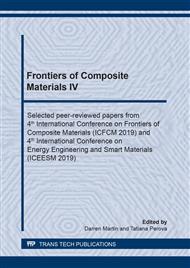p.3
p.9
p.15
p.21
p.27
p.37
p.43
p.49
Tensile Fractography of Artificially Aged Al6061-SiC+B4C Hybrid Composites
Abstract:
In the current work Al6061 hybrid composites reinforced with Silicon Carbide (SiC) and Boron Carbide (B4C) were studied for improvement in hardness and behavior of fracture surface after artificial aging. It was found that after aging at 100 and 200 OC, presence of SiC and B4C particles in the Hybrid Al6061 Matrix Composites showed substantial improvement in hardness compared to that of the base alloy. Behavior of fracture mechanism after tensile strength have been discussed to conclude the factors which impact the mechanism of crack growth. Presence of SiC and B4C reinforcement particulates and artificially aged at 100°C for Al6061-SiC+ B4C hybrid metal matrix composite shows enhancement in hardness by 180% and tensile strength by 80% due to the presence of finer secondary solute rich intermetallic phases of alloying elements. Fractography analysis displays particle interface failure and combination of brittle and ductile mode of failure.
Info:
Periodical:
Pages:
3-8
Citation:
Online since:
June 2020
Keywords:
Price:
Сopyright:
© 2020 Trans Tech Publications Ltd. All Rights Reserved
Share:
Citation:


